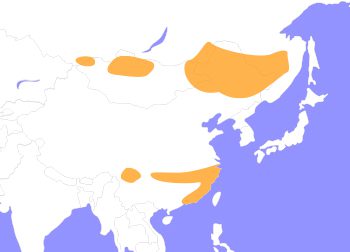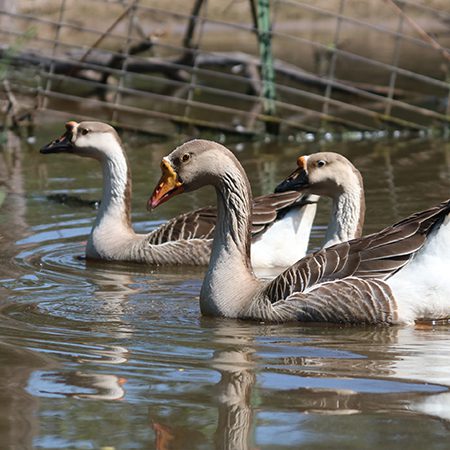African Goose
Anser anser domesticus
Historical studies show that the African Goose has been known by many names, and its origin has been attributed to many continents. It seems to have arrived in North America on ships that traveled around the world, leaving its exact origin is ambiguous. It is known that the African goose is a breed of domestic goose derived from the wild swan goose (Anser cygnoides).
Despite their name, the African goose is thought to have originated in China. Both the African goose and Chinese goose are related and share some characteristics (such as color patterns). However the two can be distinguished by the African's large dewlap and different knob shape. African geese are also quite a bit heavier than Chinese, and are known for their docile temperament. Also, they lay fewer eggs than Chinese geese: 25 to 40 eggs per year for the African goose against 40 to 65, or, in extreme cases, up to 200 eggs per year for Chinese goose.
Two varieties of Africans are found in North America, the colored variety known as either Gray or Brown, and the White variety. The plumage of the colored variety is a combination of browns, buffs, grays and white. A dark brown stripe runs over the crown of the head and down the back of the neck. On mature birds, a narrow band of whitish feathers separates the satin-black bill and knob from the brown head. The legs and feet are dark orange to brownish orange. The Brown African was admitted to the American Poultry Association's Standard of Perfection in 1874. The White African has pure white plumage, an orange bill and knob, and bright orange shanks and feet. It was admitted to the American Poultry Association's Standard of Perfection in 1987.

African Geese originated from ancestors in China. It was later introduced to Europe and the United States.
HABITAT -They inhabit forested grassy areas usually with access to a pond or other body of water.
DIET -Generally feed on larvae and pupae found under rocks, aquatic plants, plant material, seeds, small fish, snails.
FUN FACT -Goose is actually the term for female geese, male geese are called ganders.
SOCIAL BEHAVIOR -Geese will live in flocks and form into larger groups called gaggles.
ACTIVITY -They are diurnal being most active during the day and resting during the evening.
PREDATORS -Predators include foxes, wild dogs, raccoons, and humans.
SIZE -Males average 22lbs, with females averaging 18lbs.
RELATIVES -The African Geese is a descendant of the wild swan goose and related to the Chinese Goose.
CONSERVATION -African Geese are categorized as NE (Not Evaluated) species by the IUCN.
Cub Creek Animal Care Information
Housing - Our African Geese roam freely across the ranch! You can regularly find them exploring around camps fields, or usually down in the animal area by llama pond! They can usually be found roosting in the stalls of llama land.
Diet - Primarily our African Geese will forage around camp and eat wild vegetation to stay healthy! They will regularly eat plant material around ponds, as well as small invertebrates. In addition, their diet is supplemented with high quality game bird food, or bird seed. These can be found distributed all throughout camp for our free roaming avian friends.
Enrichment - They roam around camp freely, able to explore all of our land. They are also able to interact with other animals, hunting and foraging for their food. This gives the geese a lot of space to explore and never get bored!

